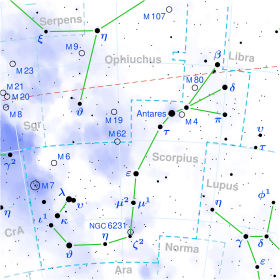
| |
| Observation data Epoch J2000 Equinox J2000 | |
|---|---|
| Constellation | Scorpius |
| Right ascension | 17 49 51.48081 |
| Declination | −37° 02′ 35.8975″ |
| Apparent magnitude (V) | 3.21 |
| Characteristics | |
| Evolutionary stage | horizontal branch |
| Spectral type | K2 III |
| U−B color index | +1.19 |
| B−V color index | +1.17 |
| Astrometry | |
| Radial velocity (Rv) | +24.7 km/s |
| Proper motion (μ) | RA: 40.59 mas/yr Dec.: 27.24 mas/yr |
| Parallax (π) | 25.92 ± 0.15 mas |
| Distance | 125.8 ± 0.7 ly (38.6 ± 0.2 pc) |
| Absolute magnitude (MV) | +0.24 |
| Details | |
| Mass | 1.2±0.2 M☉ |
| Radius | 20±1 R☉ |
| Luminosity | 93±4 L☉ |
| Surface gravity (log g) | 2.2 cgs |
| Temperature | 4,535±125 K |
| Metallicity | −0.20 dex |
| Rotational velocity (v sin i) | <1.0 km/s |
| Other designations | |
| Fuyue, G Sco, γ Tel, FK5 669, HD 161892, HIP 87261, HR 6630, SAO 209318 | |
| Database references | |
| SIMBAD | data |
G Scorpii (abbreviated G Sco), also named Fuyue, is a giant star in the constellation of Scorpius. It has an apparent magnitude of +3.19. It is approximately 126 light-years from the Sun.
Nomenclature

G Scorpii is the star's Bayer designation. It was formerly situated in the constellation of Telescopium where it was designated γ Telescopii, Latinised to Gamma Telescopii. It was resited in Scorpius and redesignated G Scorpii by Benjamin Apthorp Gould. On 30 June 2017 it was included in the List of IAU-approved Star Names.
G Scorpii bore the traditional name Fuyue (simplified Chinese: 傅说; traditional Chinese: 傅說) in ancient China. Fu Yue was a former slave that became a high-ranking minister to Shang dynasty ruler Wu Ding.
Properties
G Scorpii is an orange K-type giant. The measured angular diameter is 3.94±0.21 mas. At the estimated distance of this system, this yields a physical size of about 16 times the radius of the Sun. Calculations based on its physical properties give a diameter of about 20 R☉. With an effective surface temperature of 4,535 K, it has a bolometric luminosity of 93 L☉.
Evolutionary models show that G Scorpii has probably left the red giant branch and is now fusing helium in its core. This makes it a red clump star, at the cool end of the horizontal branch.
Just 5 arcminutes to the east is the globular cluster NGC 6441. At magnitude 3.2, G Scorpii is around 40 times brighter than the entire globular cluster.
References
- ^ van Leeuwen, F. (November 2007), "Validation of the new Hipparcos reduction", Astronomy and Astrophysics, 474 (2): 653–664, arXiv:0708.1752, Bibcode:2007A&A...474..653V, doi:10.1051/0004-6361:20078357, S2CID 18759600.
- ^ Johnson, H. L.; et al. (1966), "UBVRIJKL photometry of the bright stars", Communications of the Lunar and Planetary Laboratory, 4 (99): 99, Bibcode:1966CoLPL...4...99J.
- ^ Kallinger, T.; Beck, P. G.; Hekker, S.; Huber, D.; Kuschnig, R.; Rockenbauer, M.; Winter, P. M.; Weiss, W. W.; Handler, G.; Moffat, A. F. J.; Pigulski, A.; Popowicz, A.; Wade, G. A.; Zwintz, K. (2019), "Stellar masses from granulation and oscillations of 23 bright red giants observed by BRITE-Constellation", Astronomy and Astrophysics, 624: A35, arXiv:1902.07531, Bibcode:2019A&A...624A..35K, doi:10.1051/0004-6361/201834514, S2CID 102486794.
- Gray, R. O.; et al. (July 2006), "Contributions to the Nearby Stars (NStars) Project: Spectroscopy of Stars Earlier than M0 within 40 pc-The Southern Sample", The Astronomical Journal, 132 (1): 161–170, arXiv:astro-ph/0603770, Bibcode:2006AJ....132..161G, doi:10.1086/504637, S2CID 119476992.
- Wilson, Ralph Elmer (1953). "General Catalogue of Stellar Radial Velocities". Carnegie Institute Washington D.C. Publication. Washington: Carnegie Institution of Washington. Bibcode:1953GCRV..C......0W.
- Cardini, D. (January 2005), "Mg II chromospheric radiative loss rates in cool active and quiet stars", Astronomy and Astrophysics, 430: 303–311, arXiv:astro-ph/0409683, Bibcode:2005A&A...430..303C, doi:10.1051/0004-6361:20041440, S2CID 12136256.
- Charbonnel, C.; Lagarde, N.; Jasniewicz, G.; North, P. L.; Shetrone, M.; Krugler Hollek, J.; Smith, V. V.; Smiljanic, R.; Palacios, A.; Ottoni, G. (2020), "Lithium in red giant stars: Constraining non-standard mixing with large surveys in the Gaia era", Astronomy and Astrophysics, 633: A34, arXiv:1910.12732, Bibcode:2020A&A...633A..34C, doi:10.1051/0004-6361/201936360, S2CID 204907220.
- De Medeiros, J. R.; Alves, S.; Udry, S.; Andersen, J.; Nordström, B.; Mayor, M. (2014), "A catalog of rotational and radial velocities for evolved stars. V. Southern stars", Astronomy and Astrophysics, 561: A126, arXiv:1312.3474, Bibcode:2014A&A...561A.126D, doi:10.1051/0004-6361/201220762, S2CID 54046583.
- Ian Ridpath, "Telescopium", Star Tales, retrieved 2020-05-23.
- Naming Stars, IAU.org, retrieved 16 December 2017.
- Richichi, A.; Percheron, I.; Khristoforova, M. (February 2005), "CHARM2: An updated Catalog of High Angular Resolution Measurements", Astronomy and Astrophysics, 431 (2): 773–777, Bibcode:2005A&A...431..773R, doi:10.1051/0004-6361:20042039
- Lang, Kenneth R. (2006), Astrophysical formulae, Astronomy and astrophysics library, vol. 1 (3rd ed.), Birkhäuser, ISBN 3540296921. The radius (R*) is given by:
- O'Meara, Stephen James (2013), Deep-Sky Companions: Southern Gems, Cambridge University Press, pp. 360–363, Bibcode:2013dcsg.book.....O, ISBN 978-1139851541.
